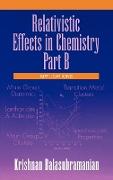Relativistic Effects in Chemistry
BücherAngebote / Angebote:
E = mc2 and the Periodic Table . . .
RELATIVISTIC EFFECTS IN CHEMISTRY
This century's most famous equation, Einstein's special theory of relativity, transformed our comprehension of the nature of time and matter. Today, making use of the theory in a relativistic analysis of heavy molecules, that is, computing the properties and nature of electrons, is the work of chemists intent on exploring the mysteries of minute particles.
The first work of its kind, Relativistic Effects in Chemistry details the computational and analytical methods used in studying the relativistic effects in chemical bonding as well as the spectroscopic properties of molecules containing very heavy atoms. The second of two independent volumes, Part B: Applications contains specific experimental and theoretical results on the electronic states of molecules containing very heavy atoms as well as their spectroscopic properties and electronic structures. The first one-volume catalog of comprehensive computational results, Part B details:
* the relativistic effects on the electronic structure of transition metal clusters, such as the Cu, Ag, and Au triad
* the electronic structure of open-shell transition metal clusters such as Rh3 and Ir3
* the electronic and spectroscopic properties of heteronuclear diatomics of main group p-block elements from Ga to Po, especially the diatomic hydrides, halides, and chalconides
* the clusters of the very heavy main group p-block elements from Ga to Po
* the relativistic effects on molecules containing lanthanide and actinide atoms, including metals inside fullerenes.
An extraordinary new examination of Periodic Table elements, Part B of Relativistic Effects in Chemistry is also evidence of the enduring influence of Einstein's revolutionary theory.
Lieferbar in ca. 10-20 Arbeitstagen




